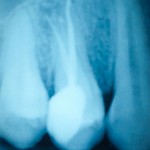Inside the tooth, under the white enamel and a hard layer called the dentin, is a soft tissue called the pulp. The pulp contains blood vessels, nerves and connective tissue, and helps to grow the root of your tooth during development. All teeth have between one and four root canals.
Endodontic treatment is a specialized dental treatment of the inside of the tooth. It is the opinion of Dr. Meyers that root canal treatment is best performed by an endodontic specialist. We have a short list of exceptional colleagues to whom we refer these treatments when necessary. Typically, a patient begins with a visit to the dentist and if there is a fitting diagnosis, when the pulp of the tooth becomes inflamed or infected, the patient is referred to an endodontic specialist.
An infected tooth (usually from decay) brings a host of problems including pain and sensitivity as the first indications of a problem. If pulp inflammation or infection is left untreated, or if it spreads, it can cause pus to develop, which can lead to an abscess.
During root canal treatment, the inflamed or infected pulp is removed and the inside of the tooth is carefully cleaned and disinfected, then filled and sealed with a rubber-like material called gutta-percha. Afterwards, the tooth is restored with a crown or filling for protection. After restoration, the tooth continues to function like any other tooth.
 Endodontic treatment helps you maintain your natural smile, continue eating the foods you love and limits the need for ongoing dental work. With proper care, most teeth that have had root canal treatment can last as long as other natural teeth and often for a lifetime.
Endodontic treatment helps you maintain your natural smile, continue eating the foods you love and limits the need for ongoing dental work. With proper care, most teeth that have had root canal treatment can last as long as other natural teeth and often for a lifetime.
Root canal therapy has a very high rate of success. In fact, root canal therapy is designed to save a problem tooth.
Procedure
Root canal therapy usually entails one to three visits. During the first visit, a small hole is drilled through the top of the tooth and into the inner chamber. Diseased tissue is removed, the inner chamber cleansed and disinfected, and the tiny canals reshaped. The cleansed chamber and canals are filled with an elastic material and medication designed to prevent infection. If necessary, the drilled hole is temporarily filled until a permanent seal is made with a crown.
Most patients who have root canal experience little or no discomfort or pain, and enjoy a restored tooth that can last almost as long as its healthy original.